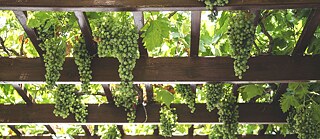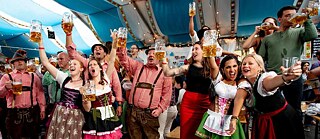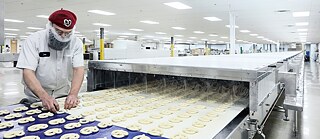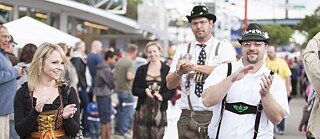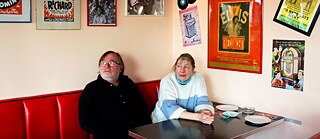Old knowledge for the new world
German-Style Wines in the U.S.
German winemakers have shaped wine manufacturing in the U.S. for over a century. We look at how riesling, Blaufränkisch, Grüner Veltliner and other old favorites are being used to create something new and unique in the U.S.
Listen to this episode: Apple Music | Spotify | Download
This episode is by Gary Lee. Gary works as a freelance journalist in Washington, D.C. He has written for “The Washington Post” and “Time Magazine” for decades. Lee often reports from abroad and is fluent in German. As a former restauranteur, he is also an avid wine lover. In this podcast, Gary explores his passion and interviews winemakers from High Pass Winery, Hermann Wiemer Vineyards, and Otium Cellars.
Transcript
Gary Lee: There’s a bar at the High Pass Winery in Junction City, Oregon, where we’re enjoying a lovely view of rolling vineyards and tasting wine.
What we’re sampling is something called ‘Crazy Eight.’ This is not your standard issue cabernet. It’s a blend, made from eight different grapes: Scheurebe, Huxelrebe, Sylvaner, Bacchus, Siegfried, Gewürztraminer, Comtesse and Gutedel. They are grapes brought from Germany and replanted in vineyards here in Oregon.
Wine drinkers among you know the grapes used for wines like chardonnay or merlot. These German grapes — and the wines made from them — have a different taste.
Dieter Boehm: You have this balance between the acid and the sugar.
Gary Lee: That’s Dieter Boehm, owner and winemaker at High Pass, explaining what makes a German-style wine different.
Dieter Boehm: Those German grapes produce very floral nose. You smell them. You think of flowers. You think of fresh fruit. That’s something that chardonnay doesn’t do, you know. And that’s the same as the flavors. There is a lot of fruitiness.
Gary Lee: I am Gary Lee. My report today is on German-style wines. I’m not talking about wines made in Germany — the Rhine wines, Franken, and other German vintages. This is about wines made from grapes that were brought from Germany and grown in U.S. soil. That’s why they’re called German-style, and not German wines.
We’ll be visiting three wineries. Each is in a different corner of the United States. And each has its own peculiar German-American wine scene. While I explored the wineries — and got to know the winemakers — I discovered something interesting: that each wine seeks to reflect the unique style and character of its maker.
Dieter Boehm was born and raised on the other side of the Iron Curtain, in communist-ruled East Germany. His father was a wine connoisseur who ran a restaurant in the mountainous Erzgebirge region, near the Czech border. Boehm has strong memories of his father’s interest in wine.
Dieter Boehm: We always had a decent wine list in this restaurant that was mostly wines from all the communist neighbors — Hungary, Romania, Bulgaria, maybe some Czech ... or the champagne from the Crimea, from Russia.
Gary Lee: As good as that wine was, it wasn’t good enough to keep Boehm in East Germany. In 1975, he escaped across the wall to the West. And eventually, he came to America and settled in Oregon. Here, he started growing grapes and opened a winery called High Pass. It’s a beautiful sprawl of vineyards, spread along rolling hills. He now cultivates over 50 acres, neatly organized rows of grapes used to make pinot noir and several German wines.
Boehm sells many of the grapes to other winemakers. But he also keeps some to make his own wine. After more than four decades living and working in Oregon, Boehm is Americanized. He’s got an adventurous West Coast spirit and his lingo is laced with terms like ‘gung ho’ and ‘snooty.’ And now he gives his name the American pronunciation of ‘Bohm,’ rather than the German ‘Boehm.’ Nevertheless, he’s still pretty proud of his German roots. And he has fun keeping up connections with Germans in the area.
Dieter Boehm: The old German immigrants that call you on the phone. And say, hey you’re that German guy who has that German wine. [LAUGHS]
Gary Lee: A couple of the wines Boehm makes seem to reflect his own hybrid character. They’re a kind of mix of German intensity and American earthiness. One is made from grapes called Scheurebe.
Dieter Boehm: It makes a good off-dry wine with a little residual sugar. And it offers interesting flavors for a white wine, because, you know, it’s the only white wine I know that has hints of cassis — you know, black currant.
Gary Lee: Huxelrebe is another grape. And Boehm tells us about the wine that it produces.
Dieter Boehm: Nice aromatic wines, a lot of peach and apricot and honey notes. So, very very nice flavors.
Gary Lee: Both Scheurebe and Huxelrebe are grapes that Boehm brought from Germany years ago in a suitcase and planted here. Besides the grapes, what makes the wines German is the method Boehm uses to make them. It’s a process common in German winemaking, emphasizing cold fermentation and oxygen deprivation.
The American part of the wines comes through the earth where the grapes grow, the so-called ‘terroir.’ First, workers graft the German grape plants onto American vines. Then they plant the grapes in a soil called bell pine, a silty clay loam over sandstone that is common in Oregon’s wine country.
After many years of making wine in Oregon, Boehm is clear about one thing: making an authentic German wine in the U.S. is really not feasible. To explain why, he gives the example of riesling, whose grapes originate in the Mosel valley of Germany.
Dieter Boehm: And those slate stone hills of the Mosel create a specific terroir that gives riesling this super floriferous character. And the fruitiness and earthiness together — that’s just not possible anywhere else.
Gary Lee: But Boehm feels it’s still very much worth it to see how close he can get to making a wine that has a German taste to it.
Dieter Boehm: You can try the style. The style of cold fermentation, no oxygen, and see what the grape variety will give you in this piece of terroir. So that is the fun part.
Gary Lee: How well does he succeed in producing wine that reflects both German and American influences? That’s a question we put to the small crowd that was sipping the latest vintage of Boehm’s ‘Crazy Eight’ blend at the High Pass bar. After a couple of glasses, they’re still trying to figure it all out.
Voice One: We have a German last name, but neither one of is German.
Voice Two: So, what’s your last name?
Voice One: Purcher. So, he’s not German and I’m not German, but we have a German last name.
Gary Lee: Jawohl. The wine was already starting to talk.
For the next stop on our German-style wine pub crawl, we high tail it across the U.S. to Hermann Wiemer Vineyards, in the hamlet of Dundee in the Finger Lakes region of New York. Fred Merwarth, co-owner and winemaker at Hermann Wiemer, took me on a tour.
Here is a huge 90-year-old barn that has been transformed into the winery’s centerpiece. Vineyards spread out as far as I can see in every direction, encompassing around 130 acres. And there’s also a huge storage area, with boxes of wine bottles piled high. They are a part of the winery’s huge production, which totals more than 17,000 cases every year. In all, it’s is an impressive operation.
But the real centerpiece of the winery may be Fred Merwarth himself. He is the chief wine guru here. And he’s on a mission: to create a perfect riesling. He makes chardonnay and other wines, too. But riesling is his biggest obsession. In fact, he makes at least 11 kinds of riesling. And with every one of them, his goal is perfection.
To me, the idea of making a perfect riesling sounds pretty lofty. But for a serious winemaker like Merwarth, it makes sense. Riesling is by far the most popular German-style wine made in the U.S. As far as my taste buds are concerned, many of them are mediocre. Merwarth is driven to make rieslings that people — and especially connoisseurs of good wine — remember.
Merwarth helped me understand why riesling is so unique and special.
Fred Merwarth: With riesling you have this whole wide view of the world, from very dry wines to extremely sweet wines and anything in between. And I think, generally, when we have tasted very fine German rieslings, the balance in the wine is just perfect, between the acid and the sweetness. That is, I think, a hallmark of the varietal, that when you hit it right with the acid and the sweetness, that you have a wine that ... I don’t think there is another varietal that can compare to that in terms of creating elegance, complexity ...
Gary Lee: It’s that balance between acid and sweetness that riesling-makers all over the U.S. — at least a hundred, including a dozen in the Finger Lakes area alone — are trying to get right. So, what’s the secret to achieving it? To find that out, I talked to various winemakers. And, naturally, I sampled a few rieslings. What I concluded is that creating a really great German-style riesling comes down to four factors. First, you need really great riesling grapes.
Fred Merwarth: The cliché in the wine industry is that you can’t make great wine from mediocre grapes. You need great grapes to make great wine. That’s absolutely true. But you can’t mess up great grapes in between making wine.
Gary Lee: Riesling grapes also thrive well in areas with strong soil variations, a terroir that changes every few hundred feet. And this winery’s vineyards have just that kind of soil. Finally, when harvest time comes, the workers here gather the grapes by hand, rather than machine. That assures that they bring in the highest quality. Another crucial factor is the winemaker’s technique. The method used at Hermann Wiemer is unique in two important ways: they plant only a limited number of grapes in the vineyards. And they let the grapes ferment a long time. Merwarth, the winemaker, explained to me the do’s and don’ts:
Fred Merwarth: Not over-producing. Having concentrated fruit coming into the winery. And then, fairly long, slow fermentations.
Gary Lee: The third element for creating a great riesling is the winery’s tradition. Here, the folks at Hermann Wiemer have a pretty big advantage. They bought this place from Hermann Wiemer himself, who was one of the pioneers of creating riesling in the Finger Lakes in the 1980s and ’90s. Wiemer came from the Mosel region of Germany and started this winery in 1979. He developed methods for making some of the most acclaimed rieslings outside of Germany. And then he hired Fred Merwarth as an apprentice in 2001, and mentored Fred for several years before selling the winery to him and his partners in 2007. Fred Merwarth likes to reflect on the years of learning about winemaking from Hermann Wiemer:
Fred Merwarth: We would finish harvest, have dinner, and talk wine while the presses were finishing ... we would finish grafting, have a glass of wine and talk. I could do that then because my wife and I were just married, we didn’t have kids. She was training as a jeweler, so she was working crazy hours. And we could just hang and talk wine.
Gary Lee: And all this drinking and talking went on for years. The fourth element is the character of the winemaker. Merwarth’s seems to be all about balance. During our day with him, it was clear that he works hard at juggling various duties: ownership and management of the winery; spending time with his family, including his wife and son. He moves around the winery deftly, but he always spoke in the measured terms of a deep thinker.
Merwarth’s family heritage also seems important to his character. He’s a third-generation German-American. His grandparents work hard to hold on to their German culture, including the speaking of the German language. But his parents, Pennsylvania Dutch farmers, were more Americanized. They opted not to learn German. Merwarth decided to reconnect with German culture. As a schoolboy, he learned the language. Later, he spent time on a couple of student exchange programs in Germany. Those were pivotal experiences for him.
So, how well does this all add up for winemaking? To find out, we popped open a bottle of Hermann Wiemer’s finest — a 2016 riesling. Cue to opening of bottle and pouring a glass. Oh, yeah. Centered just right between sweetness and acidity. Now that’s perfection! As impressive as the riesling was, I still wondered how it stands up to its counterparts made in Germany. It’s a question that Merwarth and his colleagues think about a lot.
Fred Merwarth: We do that all the time — look at rieslings within the classic sense of Germany ... and say, okay, here’s Mosel, here’s Rheingau, here’s Nahe, here’s Franken, here’s the Pfalz, here’s Rheinhessen. And look at our own production and say, stylistically, how do we compare?
Gary Lee: Every year, Merwarth brings interns from German wineries to work at Hermann Wiemer. They share what’s going on back home and offer comparisons between German and U.S. winemaking. Still, after all that, what’s most important, Merwarth says, is that rieslings — like all wines — should be the products of the terroir where the grapes are grown.
For the final stop, we scoot south, to Otium Cellars in Loudoun County, Virginia. This area, around an hour from Washington, D.C., is wine and horse country. And Otium Cellars is pretty enough to be on a calendar of the Shenandoah Mountains. The winemakers here specialize in German varietals quite different from those we encountered so far.
Gerd Bauer: We have Blaufränkish, or another German name is Lemberger. We have Dornfelder — it’s a very German varietal. We have Zweigelt — Zweigelt is Austrian German variety. We have Grüner Veltliner — it’s a little bit more in the southern part of Bavaria — so, Austrian — area.
Gary Lee: That’s the owner, Gerd Bauer. In the 1980s, he came from the Franconia region of Germany to run a company here in Virginia. After he retired 10 years ago, Bauer bought several acres of land. Together with a business partner, he decided to grow some grapes just to sell to other wineries to make wine. But they hit a snag.
Gerd Bauer: So, I asked the partner — Ben is his name — what do we do now? Stupid question, he said. We make wine. That’s how we got started!
Gary Lee: Problem solved! And a decade later, Otium Cellars’ German wines have turned out to be a really big draw. Locals like their novelty.
Gerd Bauer: The main customer base we have is ... they really enjoy to have something different, not the standard Virginia wine you can get everywhere. They really enjoy the difference and the taste of our German varieties.
Gary Lee: Although Germany is best known for its white wines, at Otium Cellars, the most popular is — by far — Blaufränkish, a light red. Like the vineyard owner, Gerd Bauer, this wine is lighthearted and easily approachable. Max Bauer, Gerd’s son and one of the winemakers, explains how this wine changes from vintage to vintage.
Max Bauer: Right now, I can tell you that our Blaufränkish has some great cherry tones and is slightly spicier. That could be for this year. Next year it could be slightly sweeter or dryer. So it varies year to year.
Gary Lee: In this part of the Shenandoah Mountains, the scenery seems just like Germany.
Gerd Bauer: I would say it looks exactly like I grew up in Germany ... rolling mountains, the Blue Ridge Mountains in the background. It’s like the area I grew up. We had Fichtel Mountains and Frankenwald — it’s mostly the same latitude around here and the same kind of rolling hills. I feel like at home.
Gary Lee: A newly built tasting complex, with high wood-beam ceilings, add to the atmosphere of Bavaria. In the end, the Bauers have created something more than a place to drink wine. They have set up a bridge between their native Germany and Virginia. People come to hang out, ride horses, hear some music, or meet others who are interested in Germany and wine. The clientele includes some locally-based Germans who want a place to speak their native tongue. And also some Americans, including ex-military who have lived in Germany. And then there are those who are just curious.
Gerd Bauer: It happens many times ... customers coming in and asking about where this wine is grown in Germany, how it looks like, and how they are doing. We have a lot of customers which have been in Germany before, mostly for the military. It’s also a nice — let’s say, start-up — for a conversation, to talk about you come from, where the wine comes from, and what the difference is. It’s always perfect.
Gary Lee: And to think it all started when a retired businessman from Germany planted a few German grapes and making some wine. This is Gary Lee for THE BIG POND.



